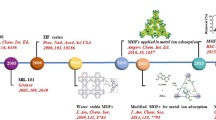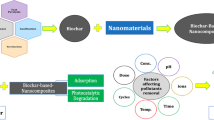Abstract
The investigation and development of technologies to remediate water contaminated with NO3− are constantly increasing. An economically and potentially effective alternative is based on the catalytic hydrogenation of NO3− to N2. With this objective, bimetallic RhMo6 catalysts based on Anderson-type heteropolyanion (RhMo6O24H6)3− were prepared and characteri3ed in order to obtain well-defined bimetallic catalyst. The catalysts were supported on Al2O3 with different textural properties and on silica. The heteropolyanion-support interaction was analysed by temperature-programmed reduction (TPR) and X-ray photoelectron spectroscopy (XPS). The differences obtained in activity and selectivity to the different products can be assigned to the different interaction between the RhMo6 Anderson phase and the supports. The RhMo6/G, (G: γ-Al2O3) system showed the best catalytic performance. This catalyst exhibited the lowest reduction temperature of Rh and Mo in the TPR assay and a Rh/Mo surface ratio similar to that of the original phase, as observed by XPS analysis. These studies allowed us to verify a synergic effect between Rh and Mo, through which Mo reducibility was promoted by the presence of the noble metal. The catalytic activity was favoured by the active sites generated from the Anderson phase. This fact was confirmed by comparing the activity of RhMo6/G with that corresponding to a conventional catalyst prepared through successive impregnation of both Rh (III) and Mo (VI) salts.








Similar content being viewed by others
References
Bae, S., Jung, J., & Lee, W. (2013). The effect of pH and zwitterionic buffers on catalytic nitrate reduction by TiO2-supported bimetallic catalyst. Chemical Engineering Journal, 232, 327–337. https://doi.org/10.1016/j.cej.2013.07.099.
Barrabés, N., & Sá, J. (2011). Catalytic nitrate removal from water, past, present and future perspectives. Applied Catalysis B: Environmental, 104, 1–5. https://doi.org/10.1016/j.apcatb.2011.03.011.
Barrett, E. P., Joyner, L. G., & Halenda, P. P. (1951). The determination of pore volume and area distributions in porous substances. I. Computations from nitrogen isotherms. Journal of the American Ceramic Society, 73, 373–380.
Bertolini, G. R., Cabello, C. I., Muñoz, M., Casella, M., Gazzoli, D., Pettiti, I., & Ferraris, G. (2013). Catalysts based on Rh (III)-hexamolybdate/γ-Al2O3 and their application in the selective hydrogenation of cinnamaldehyde to hydrocinnamaldehyde. Journal of Molecular Catalysis A: Chemical, 366, 109–115. https://doi.org/10.1016/j.molcata.2012.09.013.
Bertolini, G. R., Vetere, V., Gallo, M. A., Muñoz, M., Casella, M. L., Gambaro, L., & Cabello, C. I. (2016). Composites based on modified clay assembled Rh (III)–heteropolymolybdates as catalysts in the liquid-phase hydrogenation of cinnamaldehyde. Comptes Rendus Chimie, 19(10), 1174–1183. https://doi.org/10.1016/j.crci.2015.09.015.
Bouras, O. (2003). Doctoral thesis, Université de Limoges, Faculté de Sciences et Techniques, Francia cap. 2.
Brunauer S, Emmett PH, Teller E (BET) method. (1985). In J. R. Anderson & K. C. Pratt (Eds.), Introduction to characterization and testing of catalysts. Australia: Academic Press.
Cabello, C. I., Botto, I. L., & Thomas, H. J. (1994). Reducibility and thermal behaviour of some Anderson phases. Thermochimica Acta, 232, 183–193. https://doi.org/10.1016/0040-6031(94)80058-8.
Cabello, C. I., Botto, I. L., & Thomas, H. J. (2000). Anderson type heteropolyoxomolybdates in catalysis: 1. (NH4)3[CoMo6O24H6]·7H2O/γ-Al2O3 as alternative of Co-Mo/γ-Al2O3 hydrotreating catalysts. Applied Catalysis A: General, 197, 79–86. https://doi.org/10.1016/S0926-860X(99)00535-9.
Cabello, C. I., Botto, I. L., Muñoz, M., & Thomas, H. (2002). Catalysts based on RhMo6 heteropolymetallates. Bulk and supported preparation and characterization. Studies in Surface Science and Catalysis, 143, 565–573.
Cabello, C. I., Muñoz, M., Botto, I. L., & Payen, E. (2006). The role of Rh on a substituted Al Anderson heteropolymolybdate: thermal and hydrotreating catalytic behaviour. Thermochimia Acta., 447, 22–29.
Choi, E., Park, K., Lee, H., Cho, M., & Ahn, S. (2013). Formic acid as an alternative reducing agent for the catalytic nitrate reduction in aqueous media. Journal of Environmental Sciences, 25, 1696–1702. https://doi.org/10.1016/S1001-0742(12)60226-5.
Citak, S., & Sonmez, S. (2010). Effects of conventional and organic fertilization on spinach (Spinacea oleracea L.) growth, yield, vitamin C and nitrate concentration during two successive seasons. Scientia Horticulturae, 126, 415–420. https://doi.org/10.1016/j.scienta.2010.08.010.
Costa, A. O., Ferreira, L. S., Passos, F. B., Maia, M. P., & Peixoto, F. C. (2012). Microkinetic modeling of the hydrogenation of nitrate in water on Pd–Sn/Al2O3 catalyst. Applied Catalysis A: General, 445– 446, 26–34.
Dalmon, J. A., & Martin, G. A. (1980). Hydrogenolysis of C2H6, C3H8 and n-C4H10 over silica-supported nickel-copper catalysts. Journal of Catalysis, 66, 214–221. https://doi.org/10.1016/0021-9517(80)90023-8.
Ding, Y., Sun, W., Yang, W., & Li, Q. (2017). Formic acid as the in-situ hydrogen source for catalytic reduction of nitrate in water by PdAg alloy nanoparticles supported on amine-functionalized SiO2. Applied Catalysis B: Environmental, 203, 372–380. https://doi.org/10.1016/j.apcatb.2016.10.048.
Fierro, J. L. G., Palacios, J. M., & Tomas, F. (1988). An analytical SEM and XPS study of platinum–rhodium gauzes used in high pressure ammonia burners. Surface and Interface Analysis, 13, 25–32. https://doi.org/10.1002/sia.740130107.
Gitzen, W. H. (Ed.). (1970). Alumina as a ceramic material (1st. ed.). Wiley-American Ceramic Society. https://doi.org/10.17226/9575.
Gurvitsch, L. (1914). Physicochemical attractive force. Russian Journal of Physical Chemistry, 47, 805–812.
Haber, F., Le Rossignol R. (1910). Production of ammonium, US Patent 971501.
Harkins, W. D., & Jura, G. (1994). Surfaces of solids. XIII. A vapor adsorption method for the determination of the area of a solid without the assumption of a molecular area, and the areas occupied by nitrogen and other molecules on the surface of a solid. Journal of the American Ceramic Society, 66, 1366–1376.
Jaworski, M. A., Vetere, V., Bideberripe, H. P., Siri, G., & Casella, M. L. (2013). Structural aspects of PtSn/γ-Al2O3 catalysts prepared through surface-controlled reactions: behavior in the water denitrification reaction. Applied Catalysis A: General, 453, 227–234. https://doi.org/10.1016/j.apcata.2012.12.034.
Kim, K. S., Baitinger, W. E., Amy, J. W., & Winograd, N. (1974). ESCA studies of metal-oxygen surfaces using argon and oxygen ion-bombardment. Journal of Electron Spectroscopy and Related Phenomena, 5, 351–367. https://doi.org/10.1016/0368-2048(74)85023-1.
Kim, Y.-N., Yeob Kim, M., & Choi, M. (2016). Synergistic integration of catalysis and ion-exchange for highly selective reduction of nitrate into N2. Chemical Engineering Journal, 289, 423–432. https://doi.org/10.1016/j.cej.2016.01.002.
Lippens, B. J., & de Boer, J. H. (1965). Studies on pore systems in catalysts: V. The t method. Journal of Catalysis, 4, 319–323. https://doi.org/10.1016/0021-9517(65)90307-6.
Marchesini, F. A., Irusta, S., Querini, C., & Miró, E. (2008). Nitrate hydrogenation over Pt, In/Al2O3 and Pt, In/SiO2. Effect of aqueous media and catalyst surface properties upon the catalytic activity. Catalysis Communications, 9, 1021–1026. https://doi.org/10.1016/j.catcom.2007.09.037.
Marchesini, F. A., Gutierrez, L. B., Querini, C. A., & Miró, E. E. (2010). Pt,In and Pd, In catalysts for the hydrogenation of nitrates and nitrites in water. FTIR characterization and reaction studies. Chemical Engineering Journal, 159, 203–211. https://doi.org/10.1016/j.cej.2010.02.056.
Mizuno, N., & Misono, M. (1998). Heterogeneous catalysis. Chemical Reviews, 98, 199–218. https://doi.org/10.1021/cr960401q.
Pettiti, I., Botto, I. L., Cabello, C. I., Colonna, S., Faticanti, M., Minelli, G., Porta, P., & Thomas, H. J. (2001). Anderson-type heteropolyoxomolybdates in catalysis: 2. EXAFS study on γ-Al2O3-supported Mo, Co and Ni sulfided phases as HDS catalysts. Applied Catalysis A: General, 220, 113–121. https://doi.org/10.1016/S0926-860X(01)00707-4.
Rinaldi, R., Fred, F. Y., & Schuchardt, U. (2006). Structural, morphological and acidic changes of nanocrystalline aluminas caused by a controlled humidity atmosphere. Applied Catalysis A: General, 315, 44–51. https://doi.org/10.1016/j.apcata.2006.08.032.
Soares, O., Órfão, J., Ruiz-Martínez, J., Silvestre-Albero, J., Sepúlveda-Escribano, A., & Pereira, M. F. R. (2010). Pd–Cu/AC and Pt–Cu/AC catalysts for nitrate reduction with hydrogen: Influence of calcination and reduction temperatures. Chemical Engineering Journal, 165, 78–88.
Thommes, M., & Cychosz, K. A. (2014). Physical adsorption characterization of nanoporous materials: progress and challenges. Adsorption, 20, 233–250. https://doi.org/10.1007/s10450-014-9606-z.
Thommes, M., Kaneko, K., Neimark, A. V., Olivier, J. P., Rodríguez-Reinoso, F., Rouquerol, J., & Sing, K. S. W. (2015). Physisorption of gases, with special reference to the evaluation of surface area and pore size distribution (IUPAC Technical Report). Pure and Applied Chemistry, 87(9–10), 1051.
Vieira Coelho, A. C., Rocha, G. A., Souza Santos, P., Souza Santos, H., & Kiyohara, P. K. (2008). Specific surface area and structures of aluminas from fibrillar pseudoboehmite. Revista Matéria, 13(2), 329.
Vorlop, K.-D., & Tacke, T. (1989). Kinetic investigation of the catalytic nitrate reduction: construction of the test reactor system. Chemie Ingenieur Technik, 61, 836–837. https://doi.org/10.1002/cite.330611023.
Wagner, C. D., Davis, L. E., Zeller, M. V., Taylor, J. A., Raymond, R. H., & Gale, L. H. (1981). Empirical atomic sensitivity factors for quantitative analysis by electron spectroscopy for chemical analysis. Surface and Interface Analysis, 3, 211–225. https://doi.org/10.1002/sia.740030506.
Zhao, J., & Chen, Q. (2003). Study on enhancement in gibbsite precipitation of Bayer process under 33 kHz ultrasound. Journal of Materials Science and Technology, 19, 607–610.
Zoppas, F. M., Marchesini, F. A., Devard, A., Bernardes, A. M., & Miró, E. E. (2016). Controlled deposition of Pd and In on carbon fibers by sequential electroless plating for the catalytic reduction of nitrate in water. Catalysis Communications, 78, 59–63. https://doi.org/10.1016/j.catcom.2016.02.012.
Acknowledgements
We are grateful to Mrs. Graciela Valle, Eng. Edgardo Soto, Lic. Mariela Theiller, Dra. Laura Barbelli and Eng. Hernán Bideberripe for their contribution and technical support.
Funding
This study received financial support from the following institutions: CONICET (PIP 0276 and 0003), ANPCyT (PICT 0409) and UNLP (Subsidio Jóvenes Investigadores, Subsidio de Viajes) and Projects I172, X633 y X700; and CICPBA (Project 832/14).
Author information
Authors and Affiliations
Corresponding author
Rights and permissions
About this article
Cite this article
Jaworski, M.A., Bertolini, G.R., Cabello, C.I. et al. Use of Rh (III)-Heteropolymolybdate as Potential Catalysts for the Removal of Nitrates in Human Drinking Water: Synthesis, Characterisation and Catalytic Performance. Water Air Soil Pollut 229, 309 (2018). https://doi.org/10.1007/s11270-018-3962-3
Received:
Accepted:
Published:
DOI: https://doi.org/10.1007/s11270-018-3962-3




